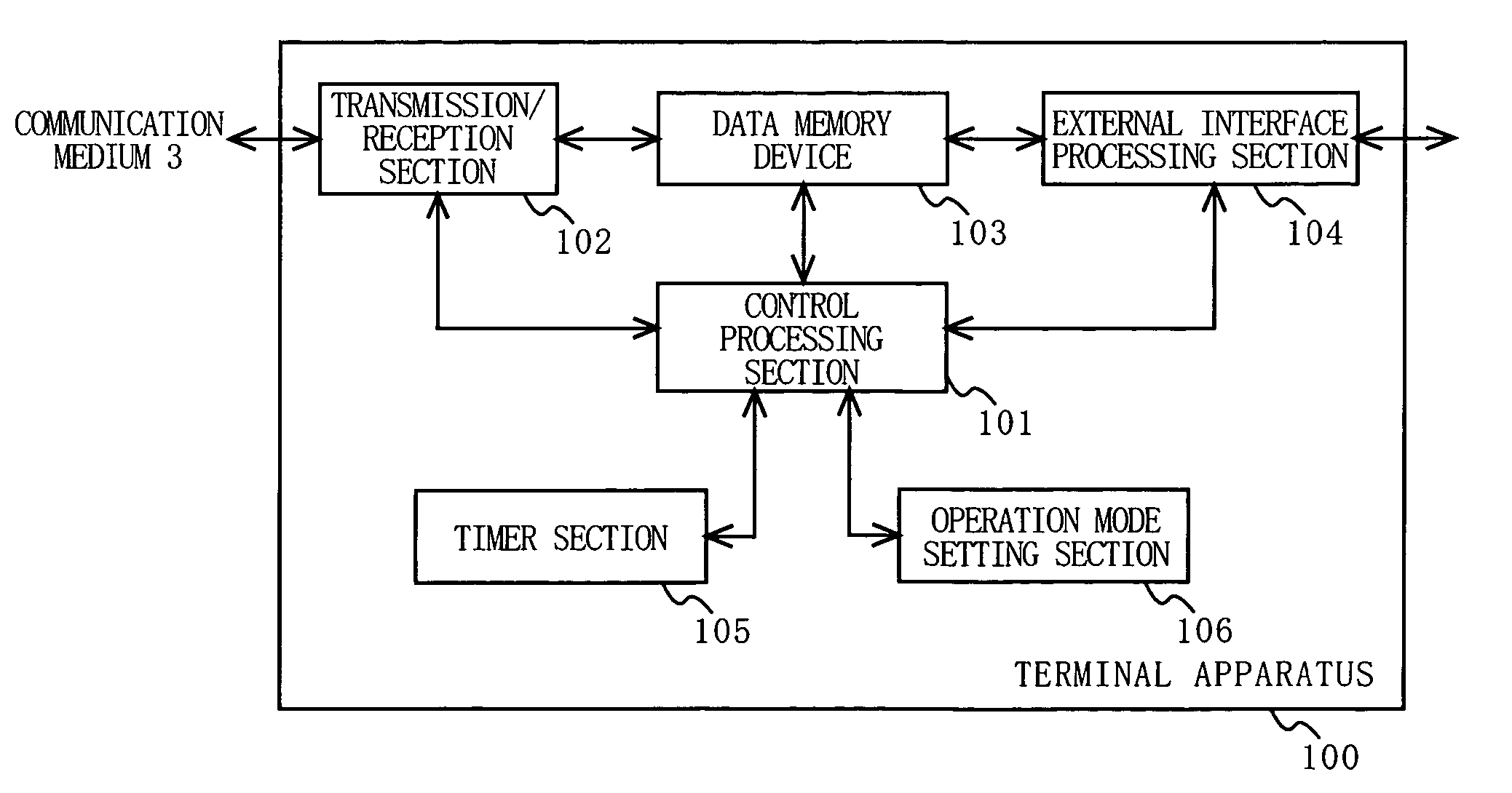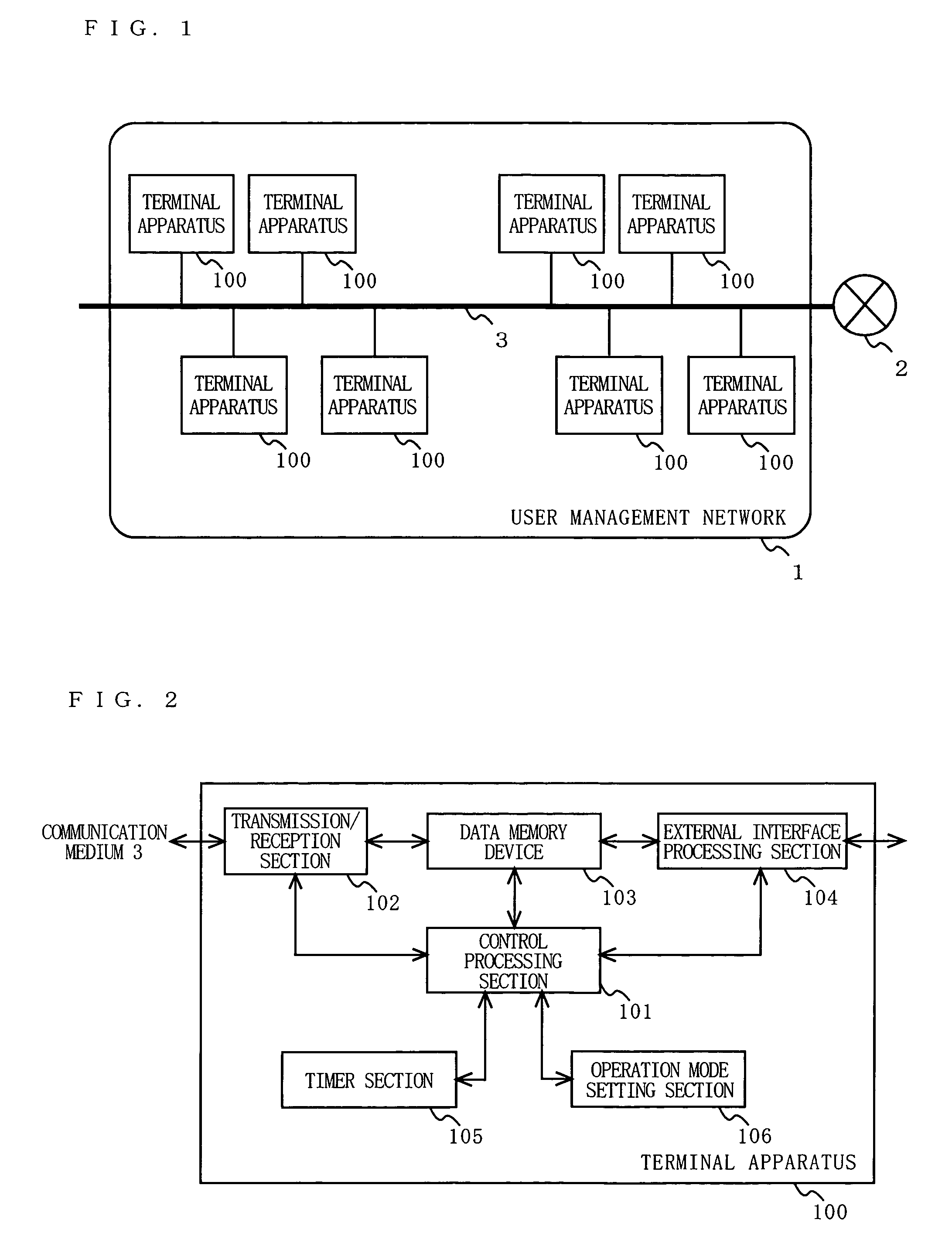Terminal apparatus
a technology of terminal apparatus and terminal cable, which is applied in the direction of multiplex communication, data switching network, instruments, etc., can solve the problems of data transmission delay or data jitter, and may not provide sufficient band, so as to prevent the efficiency of communication medium use. , the effect of reducing the efficiency of communication medium
- Summary
- Abstract
- Description
- Claims
- Application Information
AI Technical Summary
Benefits of technology
Problems solved by technology
Method used
Image
Examples
first embodiment
[0068]FIG. 1 is a diagram illustrating a structure of a whole system according to a first embodiment of the present invention. In FIG. 1, the system comprises a user management network 1 and an external network 2. The user management network 1 comprises a plurality of terminal apparatuses 100 which are connected together via a communication medium 3. Although eight terminal apparatuses 100 are illustrated in FIG. 1, the number of terminal apparatuses 100 is not limited to this. One terminal apparatus 100 transmits and receives a frame to and from at least one other terminal apparatus 100 via the communication medium 3. Although the communication medium 3 is illustrated as a wired medium in FIG. 1, it may be a wireless medium. On the user management network 1, for example, video transmission, audio transmission, voice transmission, Web browsing, file transfer, or the like is performed. The user management network 1 is operated in accordance with a centralized control type network con...
second embodiment
[0173]In the first embodiment, it is assumed that, after a failure is eliminated, a frame from each terminal apparatus reaches all terminal apparatuses. In the second embodiment, a method of unifying logical networks when a frame from each terminal apparatus does not reach all terminal apparatuses, will be described.
[0174]In the second embodiment, a structure of a whole system thereof is similar to that of the first embodiment, and will be described with reference to FIG. 1. Also in the second embodiment, a functional structure of each terminal apparatus is similar to that of the first embodiment, and will be described with reference to FIG. 2. In the second embodiment, each terminal apparatus can operate either in the control terminal mode or in the controlled terminal mode. Each terminal apparatus is assumed to have a function to, even if a control terminal has been once determined, change between a control terminal and a controlled terminal of a logical network, depending on the ...
third embodiment
[0234]In the first and second embodiments, exemplary unification and interference of networks in which communication is performed with the same channel have been described. In a third embodiment, as an example, a network form which is used for wireless LAN or the like, and in which a transmission band is divided into a plurality of channels, will be described. The functional structure of each terminal is similar to that of the first embodiment and will be described with reference to FIG. 2. Note that the transmission / reception section 102 defines and manages channels divided in terms of frequency, and has a function to perform transmission / reception appropriate for a channel used in communication. In the third embodiment, each terminal apparatus can operate in a control terminal mode (hereinafter referred to as an access point mode in the third embodiment) or a controlled terminal mode (hereinafter referred to as a station mode in the third embodiment). Each terminal apparatus also ...
PUM
 Login to View More
Login to View More Abstract
Description
Claims
Application Information
 Login to View More
Login to View More - R&D
- Intellectual Property
- Life Sciences
- Materials
- Tech Scout
- Unparalleled Data Quality
- Higher Quality Content
- 60% Fewer Hallucinations
Browse by: Latest US Patents, China's latest patents, Technical Efficacy Thesaurus, Application Domain, Technology Topic, Popular Technical Reports.
© 2025 PatSnap. All rights reserved.Legal|Privacy policy|Modern Slavery Act Transparency Statement|Sitemap|About US| Contact US: help@patsnap.com



